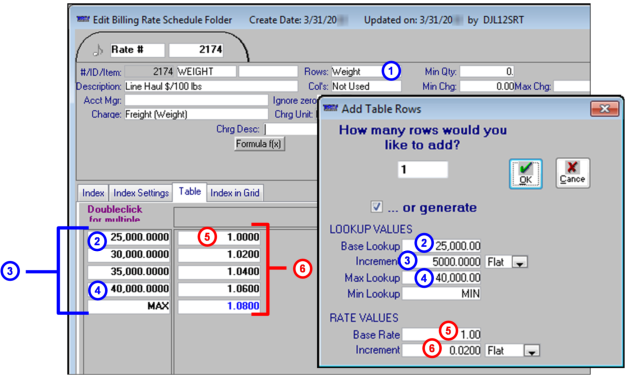Example of auto generated rate table
In the rate example shown below, we created a table based on ranges of total weight. The numbered callouts on this illustration give a visual description of how our entries in the LOOKUP VALUES and RATE VALUES fields were used to generate the rate table.

These tables of descriptions use the same callouts to provide additional information.
LOOKUP VALUE fields | ||
|---|---|---|
Callout | Field | How our entries affected the rate table |
1 | Rows | The table's rows are based on ranges of total weight |
2 | Base Lookup | We entered 25,000 as the Base Lookup value. The weight range starts at a quantity of 25,000 pounds. |
3 | Increment | We entered 5,000 as the Increment value. The quantities in the weight range increase in increments of 5,000 pounds. |
4 | Max Lookup | This field determines the last numeric quantity in the range. Because we entered 40,000, the last quantity in the range is 40,000. The system added one more row to the table and assigned a value of MAX. The MAX row ensures that pay will be calculated if the quantity for a trip is greater than 40,000 pounds. Note: In some instances, the system will create a table in which the last quantity is less than the quantity you entered in the Max Lookup field. For example this could happen if you made these entries to auto-generate the table: Base Lookup: 25,000 Increment: 5,000 Max Lookup: 42,000 The system would generate this range of values: 25,000, 30,000, 35,000, 40,000, MAX Although 42,000 was entered as the Max Lookup value, the incremental amount of 5,000 prevents the system from ending with a value of 42,000 (because 40,000 +5,000 = 45,000). So the system assigned 40,000 as the Max Lookup value. |
RATE VALUE fields | ||
|---|---|---|
Callout | Field | How our entries affected the rate table |
5 | Base Rate | We entered $1.00 as the Base Rate value. Therefore, the system applies a rate of $1.00 per pound for trips that total 40,000 pounds or less. |
6 | Increment | We entered $.02 as the Increment value. As a result, the rates in the table increased in increments of $.02. |